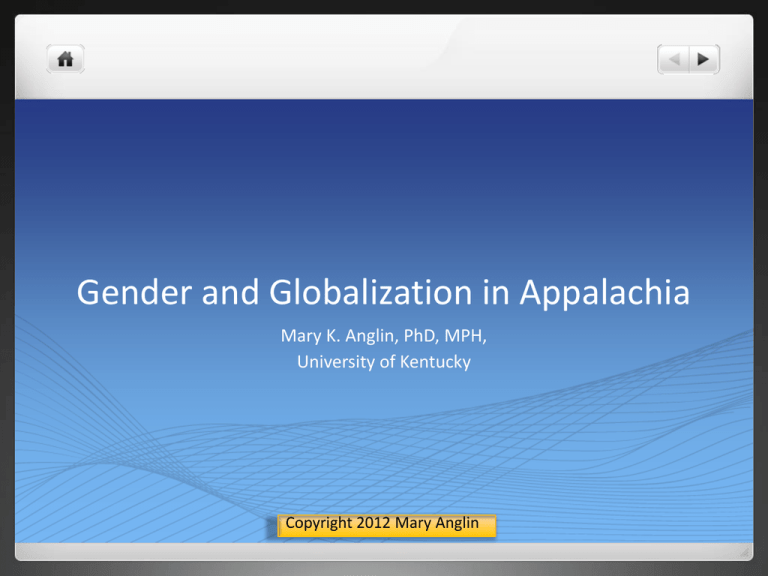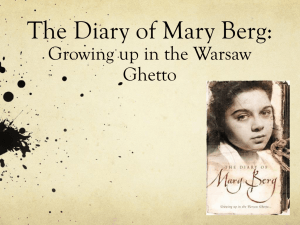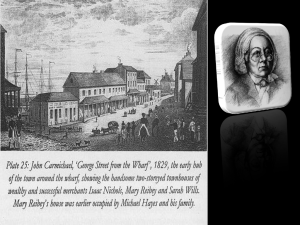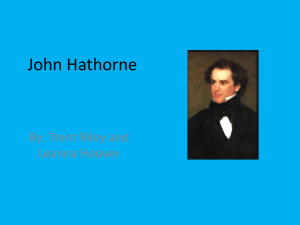Gender and Globalization in Appalachia
advertisement

Gender and Globalization in Appalachia Mary K. Anglin, PhD, MPH, University of Kentucky Copyright 2012 Mary Anglin Appalachia in the 21st century “The question is how will we locate ourselves as both Appalachian and global citizens, and how will we link with those voices speaking from the margins and the fringes of global power elsewhere?” John Gaventa, “Appalachian Studies in Global Context,” 2002 Copyright: Mary Anglin, 2012 Situating Appalachia globally “The connections that global capitalism creates are not confined within national borders, much less vague regional boundaries. The most strategic relationships we need to create may not be intra-regional but trans-local. If we follow the money that is alternately destroying and reconstituting community after community in Appalachia, to what other local places and larger relations of power does it lead us?” Barbara Ellen Smith, “The Place of Appalachia,” 2002 Copyright: Mary Anglin, 2012 “Placing”: Power and identity in Appalachia “People have a powerful penchant for placing ourselves and others. It is how we tell where we are at any given moment in a maze of shifting contexts as we negotiate identities, livelihoods, communities, memoryscapes, and landscapes.” Ann Kingsolver, Tobacco Town Futures, 2011 Copyright: Mary Anglin, 2012 The Appalachian Region Copyright: Mary Anglin, 2012 The Appalachian Regional Commission (ARC) Defining Appalachia in Geographic Terms: “The Appalachian Region, as defined in ARC's authorizing legislation, is a 205,000-square-mile region that follows the spine of the Appalachian Mountains from southern New York to northern Mississippi. It includes all of West Virginia and parts of 12 other states: Alabama, Georgia, Kentucky, Maryland, Mississippi, New York, North Carolina, Ohio, Pennsylvania, South Carolina, Tennessee, and Virginia. Forty-two percent of the Region's population is rural, compared with 20 percent of the national population.” www.arc.gov Copyright: Mary Anglin, 2012 ARC: economic conditions in Appalachia “The Appalachian Region's economy, once highly dependent on mining, forestry, agriculture, chemical industries, and heavy industry, has become more diversified in recent times, and now includes manufacturing and professional service industries. Appalachia has come a long way in the past four decades: its poverty rate, 33 percent in 1965, was 18 percent in 2008. The number of high-poverty counties in the Region (those with poverty rates more than 1.5 times the U.S. average) declined from 295 in 1965 to 116 in 2000.” Copyright: Mary Anglin, 2012 ARC: economic conditions in Appalachia (continued) “But despite progress, Appalachia still does not enjoy the same economic vitality as the rest of the nation. Central Appalachia in particular still battles economic distress, with concentrated areas of high poverty, unemployment, poor health, and severe educational disparities. And recent economic data show that the Region has fared far worse in the current recession than the rest of the nation.” ARC refers to this recent period as “the lost decade.” www.arc.gov/appalachian_region/AppalachiasEconomy.asp Copyright: Mary Anglin, 2012 Describing Appalachia’s “lost decade” As a result of the U.S. economic recession (2008-), the Appalachian Region lost all jobs gained since 2000. Using 2010 rates, unemployment is higher in Appalachia: 9.7% as compared with 9.6% for the nation. Per capita market income in Appalachia is only 75% of the national average This measure includes personal income minus “transfer payments.” Federal expenditures for Appalachia are 33% lower than for the U.S. as a whole In Central Appalachia, the rate is 10.9%. Economic development and infrastructure are under-funded Retirement and disability payments are higher in Appalachia than for the U.S. Source: ARC, “Economic Overview of Appalachia-2011,” accessed 2012 Copyright: Mary Anglin, 2012 How has Appalachia’s persistent poverty been explained? From the standpoint of popular media and the federal government—including the ARC—there is little reason to look for external sources Emphasis is placed, instead, on the idea of “Appalachian exceptionalism”: Assumptions about geographic, cultural, and social isolation The “Local Color Movement” of the mid- to late-19th century “Culture of poverty” theories in the mid-20th century Stereotyped imagery—presented as documentary– in 20th and early 21st centuries Dwight Billings, Mary Beth Pudup, and Altina Waller, Appalachia in the Making, 1995 (See also Batteau, The Invention of Appalachia, 1990 and Shapiro, Appalachia on Our Mind, 1978) Copyright: Mary Anglin, 2012 Examples of the “Local Color” Approach Will Wallace Harney presented Appalachia as William Goodell Frost (President of Berea College) “A Strange Land and a Peculiar People” (Lippincott Magazine, 1870) regarded southern mountaineers as pure relics of the “Anglo Saxon race” and “Our Contemporary Ancestors” (Atlantic Monthly, 1899) John Fox, Jr. (The Trail of the Lonesome Pine, 1908) offered the following explanation: “You see, mountains isolate people and the effect of isolation on human life is to crystallize it. Those people over the line (in Kentucky) have no navigable rivers, no lakes, no wagon roads except often the beds of streams. They have been cut off from all communications with the outside world. They are a perfect example of an arrested civilization and they are the closest link we have with the Old World.” Copyright: Mary Anglin, 2012 Culture of Poverty Theories: Distinctiveness interpreted as deficit British historian Arnold Toynbee described Appalachia as In his highly influential book, Jack Weller depicted the residents of Appalachia as the “melancholy spectacle of a people who acquired civilization and then lost it.” (A Study of History, 1947) fatalistic; lacking ambition, education, or intelligence; and poorly disposed to the caretaking of others (Yesterday’s People, 1969). In a foreword to Yesterday’s People, Rupert Vance summed up the argument: “Thus mountain isolation, which began as physical isolation enforced by rugged topography, became mental and cultural isolation, holding people in disadvantaged areas, resisting those changes that would bring them into contact with the outside world. The effect of conditions thus becomes a new cause of conditions, but the cause is now an attitude, not a mountain.” Copyright: Mary Anglin, 2012 The Persistence of Stereotypes Journalist Peter Appelbome reporting on President Clinton’s trip to Appalachia: Playwright Robert Schennkan describing Central Appalachia: “What never seems to change is the mythology of the place as the poster child for American poverty, an image that persists, to the region’s detriment and benefit, no matter how much times change.” (New York Times, 1999) “The poverty and environmental abuse I witnessed there was not simply a failure of economics. It went much deeper than that; hence our continual failure to ‘social engineer’ meaningful changes there. It was a poverty of the spirit, a poverty of the soul. What I was a witness to there was a vision of the future.”(Author’s Notes, The Kentucky Cycle, 1993). Diane Sawyer introducing A Hidden America: Children of the Mountains (2009): “In the hills of Central Appalachia, up winding, mountain roads, is a place where children and families face unthinkable conditions, living without what most Americans take for granted.” Copyright: Mary Anglin, 2012 Appalachia Reconsidered Addressing the relationship between poverty and economic plans for Appalachia– especially the appropriation of the mountains’ “natural” wealth Helen Lewis, Linda Johnson, and Don Askins, eds., Colonialism in Modern America (1978) John Gaventa, Power and Powerlessness (1982) Ronald Lewis, Transforming the Appalachian Countryside (1998) Ron Eller, Uneven Ground (2008) Rebecca Scott, Removing Mountains (2010) Paying attention to social activism and labor movements Stephen Fisher, ed., Fighting Back in Appalachia (1993); with Barbara Ellen Smith, eds. Transforming Places (2012) Mary Ann Hinsdale, Helen Lewis, and Maxine Waller, It Comes from the People (1995) Robert Brisbin Jr., A Strike Like No Other (2002) Copyright: Mary Anglin, 2012 Resurrecting History: Racial and Ethnic Diversity in the Southern Mountains “I have a great many grandchildren, and I wish them to do well on our land.” Ward, Speech, Cherokee Council for Cherokee Women, 1817 “My darkest fear is that Piedmont, West Virginia will cease to exist, if some executives on Park Avenue decide that it is more profitable to build a completely new paper mill elsewhere than to overhaul one a century old. Then they would close it, just as they did in Cumberland with Celanese, and Pittsburgh Plate Glass, and the Kelly-Springfield Tire Company. The town will die, but our people will not move. They will not be moved. Because for them, Piedmont—snuggled between the Allegheny Mountains and the Potomac River Valley—is life itself.” Henry Louis Gates, Jr., Colored People, 1994 Copyright: Mary Anglin, 2012 Nancy Sites of Diversity The creation of a multinational workforce and multi-ethnic communities in the West Virginia coalfields – Recruitment of African Americans to the coal mines of Eastern Kentucky and West Virginia – Joe William Trotter, Jr., Coal, Class, and Color (1990) The establishment of Jewish communities, enterprises, and identities, in the Central Appalachian coalfields – Ronald L. Lewis, ed., Scotts Run (1994) Deborah Weiner, Coalfield Jews (2006) The interaction of skilled European and Appalachian laborers in the glass industry– Ken Fones-Wolf, Glass Towns (2007) Copyright: Mary Anglin, 2012 Erasing Difference and Creating the Perception of “White Public Space” Through forced migration Through litigation The loss of farmland and stores by freed African Americans through whites’ manipulation of the court system in 19th century Kentucky – Dwight Billings and Kathy Blee, The Long Road to Poverty (2000) Through job loss The removal of the Cherokee Nation from the southeastern U.S. to Oklahoma, with the exception of Ward’s Eastern Band of the Cherokee – Theda Perdue and Michael Green, The Cherokee Nation and the Trail of Tears (2008); see also Darlene Wilson and Patricia Beaver, “Transgressions in Race and Place” (1999) The closing of coal mines and coal fields communities in the mid- and late- 20th century – William H. Turner and Edward Cabbell, eds., Blacks in Appalachia (1985) Through racial-ethnic conflict The activities of “lynch mobs” and threatened violence in the 20th century, as the sequel to slavery in parts of Appalachia – John Inscoe, ed., Appalachians and Race (2000) Copyright: Mary Anglin, 2012 Recognizing Women in Appalachia’s Past and Present: A work in progress “The history of Appalachia is a drama written largely by and about men. Farmers, landowners, bankers, coal miners, coal operators, lawyers, politicians-the cast of historical characters has been an all-male revue. Women have been extras, hidden behind quilts and sunbonnets in tradition-bound domestic roles that supported their husbands, sons, and fathers as they transformed the region and made its history. There are exceptions. Mother Jones, for example, or the ‘fotched-on women,’ come immediately to mind. But apart from a few, specific individuals, women’s experiences and perceptions have been peripheral in the major works of Appalachian history.” Barbara Ellen Smith, “’Walk-ons’ in the Third Act,” 1998 Copyright: Mary Anglin, 2012 Why Focus on Gender? Rather than simply “setting the record straight,” the impetus for studies of women and gender in Appalachia is that of: examining the region’s complexities, past and present asking new kinds of questions calling attention to the practical activities and situated knowledge of women and men in particular communities investigating the varied manifestations and consequences of power documenting the impact of trans/national capital on regional settings inquiring about how local conditions articulate with accepted categories regarding social “difference” considering the ways in which convention might be used to justify-- or contest-- practices of subordination Copyright: Mary Anglin, 2012 Important Scholarly Contributions Elizabeth Englehardt, ed. Beyond Hill and Hollow (2005) Sarah Hill, Weaving Women’s Worlds (1997) Bell Hooks, Belonging (2009) Marat Moore, Women in the Mines (1996) Emily Satterwhite, Dear Appalachia (2011) Copyright: Mary Anglin, 2012 My ethnography, Women, Power and Dissent in the Hills of Carolina (2002): Undermining the view of a quirky, isolated region meriting its own specialized scholarship but otherwise irrelevant to serious study of the U.S. Focusing on women’s labor in processing the mineral, mica– significant to the local and national economy in the late nineteenth and most of the twentieth century ( now largely displaced by imported products) Examining an industry that has always been connected with global economies mica mining and processing (largely in India but also African countries, Canada, US) the strategic use of mica in war-related technologies, in biomedical equipment (including diagnostics and radiation treatment), and communications technologies Studying gender on the factory floor practices of dissent against patriarchal authority women’s actions in looking out for each other complications of class and religious differences but NOT of ethnicity (an all-white labor crew) Copyright: Mary Anglin, 2012 Global Appalachia A part of the U.S. characterized by a distinctive geography— one of the oldest mountain chains in the world a strong sense of identity tied to place heterogeneity with respect to race, ethnicity, nationality, and class as well as gender a history of economic and political exploitation a long tradition of activism connections with other peoples and places internationally– through geographic similarities, shared economic and political concerns, vibrant cultural practices, and the commitment to social justice Copyright: Mary Anglin, 2012








